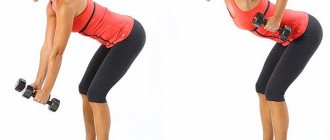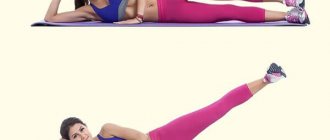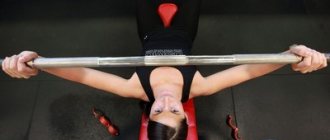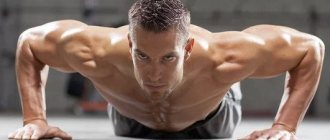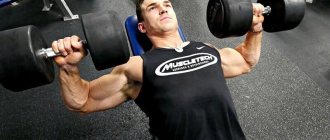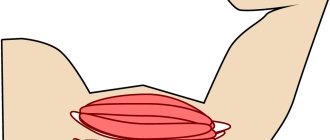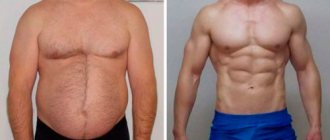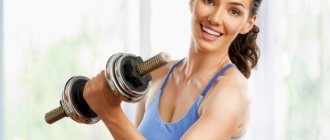The most effective chest training requires the presence of sports equipment: benches, barbells, dumbbells and various exercise machines. All this is a must have in every gym. However, not everyone has the desire or opportunity to go to the gym. We will tell everyone who wants to train at home how to pump up their pectoral muscles at home.
For productive home workouts, you should at least purchase dumbbells. They don’t take up much space, and will bring considerable benefits for training. It is better to take collapsible dumbbells: their weight can be increased or decreased if necessary.
A little anatomy
The pectoral (pectoral) muscles consist of the following symmetrical groups, each of which includes:
- Pectoralis major muscle. It is fan-shaped and located on the front surface of the chest.
- Pectoralis minor muscle. It has a triangular shape and is located in the upper chest under the pectoralis major muscle.
- Serratus anterior muscle. Located in the anterior chest wall.
The major and minor muscles provide adduction and flexion of the arms at the shoulder joint, as well as partial rotation of the arms inward. The chest is conventionally divided into upper, middle and lower sections. There is also an internal part that can be pumped separately. The middle part works actively during any exercise, and the lower and, especially, the upper parts require accentuated load. Chest training is very energy-intensive, so it can be used to burn excess fat deposits.
Home workouts
A busy work schedule, business trips, inconvenient location of the gym, reluctance to work out in a group and a number of other arguments may become reasons not to visit the gym, but should not become reasons to give up a beautiful and strong figure. You can practice at home with no less success. What matters more is not the place of training, but the diligence and determination of the athlete.
Next, we will figure out how to pump up the pectoral muscles at home. Beginners often have difficulty creating a program, but as they gain experience, the problems will disappear.
Recommendations for girls on training
In order to carry out training to correct the shape of the pectoral muscles and glands as effectively as possible, you need to follow the following recommendations:
- You cannot start training exercises without warming up. Therefore, before the main exercises, it is worth performing several simple ones, for example, turns or tilts of the head and torso. You can also take about 10-15 minutes. run on an elliptical or treadmill to prepare your body.
- Complex exercises that require a lot of energy, such as the bench press, should be performed at the beginning of the workout, while you have the strength.
- When performing the bench press exercise, you must correctly set the height at which the bar will be located. It is advisable to position it so that during capture the arms are bent, forming an angle of 20°. This is necessary so that when you grab it and prepare for the exercise, there are no difficulties in removing it.
- The bar should be grasped with an overhand grip, and the hands should be kept at such a width that the index finger is located on the inside of the extreme mark. This distance is usually wider than a woman's shoulders.
- When lifting the barbell, your arms should move slightly diagonally. When the bar is lowered, the bar is located opposite the eyes, and when raised up, it is between the chest and neck.
- It is better to start each workout with a training set with a lower weight than usual. The number of repetitions is 15 pieces. You need to gradually increase the weight of the forestay with each approach until it reaches the working value.
By following all the rules and recommendations for training aimed at maintaining the tone of the pectoral muscles in the gym, you can not only significantly improve the appearance of your breasts, but also maintain good physical shape and health.
Training mode
To the question of how many times a week you need to pump up your pectoral muscles, the answer is simple: you can’t train every day. Any strength exercises on the chest performed every day can harm a beautiful figure. During training, the muscles actively work and receive many microtraumas, after which time is needed to restore muscle fibers and produce protein, which will form new muscle mass. Systematic overload of the pectoral muscles will not give good results.
If the muscles continue to hurt severely, exercise should be postponed until the discomfort stops. That is why the optimal amount is one or two workouts per week. The total number of approaches for all chest exercises should be from 4 to 8. For beginners, one or two exercises of 2-3 approaches will be enough.
Pushups
It is quite enough to do push-ups regularly to pump up your pectoral muscles. Essentially, this is a variation of the bench press and here it is also possible to shift the load to the upper or lower chest by changing the angle of the body. It's no secret that push-ups are an excellent general development exercise. Not only the chest is worked, but also the deltoids and triceps, ensuring proportional development of the upper body. Additionally, the abdominal muscles contract, and in a static position the muscles of the legs and back are activated. Wide-arm push-ups work the chest muscles to a greater extent than the shoulder girdle and arms.
You can limit yourself to just push-ups if you want to pump up your chest at home, but there is no desire or time to do other exercises. The effect, although small, will still be felt after just a few weeks of regular training.
The best exercises for chest muscles at home
The main basic chest exercise performed with your own weight is push-ups. It is around them that we will build the entire home training process. Let's look at the most common variations of this exercise.
Push-ups with wide arms
This exercise is often called the “reverse bench press” - the biomechanics of the movements are almost identical, so as part of home training, classic push-ups will be basic.
Use the maximum possible amplitude: at the lowest point between your body and the floor there should be no more than 5 cm. If your physical fitness for this exercise is not yet enough, first perform push-ups from your knees - this way you will strengthen the muscle frame and prepare the joint-ligamentous apparatus for more serious work.
Plyometric push-ups
Plyometric push-ups are an explosive movement that works all the fibers in the pectoral muscles. The most common variation is clap push-ups. Excellent for developing explosive power and strengthening the entire shoulder girdle. More complex variations: with two claps, with a clap behind the back, superman push-ups, etc. Alternate them from workout to workout.
Deep push-ups
For this exercise you will need a pair of dumbbells (weight is not important) or a small elevation (alternatively, you can use two chairs). The amplitude is greater than in classic push-ups, so you stretch the muscles more strongly at the bottom. The result is new stress and more incentives to grow.
© kucherav — stock.adobe.com
If you have special sports equipment at home (dumbbells, weights, barbell), then you can do more strength work. This will create even more prerequisites for gaining muscle mass.
Dumbbell floor press
This is the only strength exercise for pumping up the pectoral muscles at home, which does not require a special bench or other equipment. You simply lie down on the floor, bend your knees for greater stability, and press the dumbbells up, then lower them until your hands touch the floor. The amplitude will be less than when pressing on a bench, so if it is available, it is better to perform the exercise on it.
A combined option is possible: bench press + fly-out. To do this, you need to spread your arms further to the sides and bend your elbows less.
It is possible to perform this exercise using two weights. You can press them similarly to dumbbells or one at a time:
Dips
Often at home there is a wall bars with bars, or a similar apparatus is in the nearest yard. These push-ups are one of the main basic exercises for the pectoral muscles.
To maximize the load on your chest, the distance between the bars should be slightly wider than your shoulders, and when performing the movement, lean forward slightly and do not fully extend your arms. This is how you can almost completely “turn off” the triceps.
Pullover with dumbbell
This exercise perfectly forms the “collar” - the middle of the upper part of the pectoral muscles. It does not require a lot of weight; it is much more important to feel the work of the pectoral muscles, and not the serratus or latissimus dorsi muscles. To create the correct angle of inclination of the body, an ordinary chair or stool will be enough.
© Nicholas Piccillo — stock.adobe.com
Also, the pectoral muscles work indirectly when performing some abdominal exercises, for example, when rolling on a roller, running in a prone position, or lifting from a plank. To further strengthen your core, we recommend performing one of these exercises at the end of each at-home chest workout.
Narrow push-ups
Narrow push-ups can be used to develop strength and work the inner chest. The starting position in this case is the same as for regular push-ups, but you need to place your hands in such a way that the fingers of one hand slightly touch the fingers of the other. When performing, you need to lower yourself until your chest touches your hands, and before moving up, take a second pause.
Advice! If push-ups are too easy, do not increase the number of repetitions; it is better to use additional weights. For this you can use, for example, a backpack with books.
Push-ups on stools
A more effective way to pump up your pectoral muscles with push-ups is as follows. You need to place 2 stools approximately shoulder width apart. Take the starting position, as when doing push-ups from the floor, only place your hands on stools and your feet on the floor or on a raised platform, for example, a sofa or chair. Place your palms slightly wider than your shoulders.
Going as low as possible between the stools, perform 3-4 sets of 10-12 push-ups. Breaks between approaches should be approximately 2-3 minutes.
How to pump up your pectoralis major muscles in 28 days
Use these 2 workout programs to get massive pecs in just one month.
Beach season is just around the corner, which means stop aimlessly doing rep after rep. If you want to get bigger breasts, then you need a scientific approach to training. Rotate through the following lab-tested workout programs to build muscle faster than ever. You'll be wearing larger T-shirts in no time!
Program No. 1: Volume training
The foundation of growth is strength. Blending good old German volume training with innovative Tabata protocols will increase blood flow to your muscles for amazing results. Rest for 2 days before moving on to program #2.
Bench press
Number of approaches: 10 / Number of repetitions: 6 / Rest time: 60 sec
Place the barbell on the power rack. Lie on a horizontal bench face up. Grab the bar shoulder-width apart with an overhand grip. Remove the barbell from the racks and carry it with outstretched arms so that it is above your chest. This is the starting position. Inhale and slowly lower the bar until the bar touches the middle of your chest. Exhaling, explosively lift the barbell up to the starting position. These movements constitute one repetition.
Perform the following 4 exercises twice to improve blood flow to the muscles (providing them with nutrients) and also improve posture, correcting any imbalances. You can perform these exercises not only in the gym, but also anywhere else.
Push-ups with palms back
Number of approaches: 1 / Execution time: 60 sec / Rest time: 90 sec
Take a lying position, but place your palms so that your fingers are facing towards your feet. Lower your torso down until there is a distance of about 3 cm between your chest and the floor. Extending your arms, lift your torso up with an explosive movement.
Classic push-ups
Number of approaches: 1 / Execution time: 60 sec / Rest time: 90 sec
Take a lying position. The hands are directly under the shoulders, the body is straight. To maintain a straight body posture from head to toe, keep your core tight. Lower your torso down until there is a distance of about 3 cm between your chest and the floor. Extending your arms, lift your torso up with an explosive movement.
Incline push-ups
Number of approaches: 1 / Execution time: 60 sec / Rest time: 90 sec
Take a lying position with your hands resting on the bench. Place your arms slightly wider than your shoulders. Place your feet on the floor. Bend your arms and lower your torso until your chest touches the bench. Extend your arms and rise back to the starting position.
Push-ups with cotton
Number of approaches: 1 / Execution time: 60 sec / Rest time: 90 sec
Take a lying position, hands shoulder-width apart, back straight. Lower your torso down until your chest barely touches the floor. Push off the floor with an explosive force so that you can clap your hands in the air. Land on your palms and continue the exercise.
Program No. 2: Detailed muscle work
Stimulating the connective tissue of the muscles can improve your results. The following training program allows you to increase the stretch of the fascia to better target the pectoralis major and minor muscles. Rest for 2 days before moving on to program #1. Follow the cycle for 28 days.
Muscle stretching
Number of approaches: 1 on each side / Execution time: a few seconds / Rest time: 60 sec
Stand up straight. Place your hand behind your back and place it on your lower back. Pull your shoulders back and stick your chest forward. Return to the starting position.
Incline Dumbbell Press
Number of approaches: 4 / Number of repetitions: 12 / Rest time: 60 sec
Set the bench at a 45° angle and lie face up on it. Take dumbbells and lift them to chest level, with your palms facing forward. Tightening your pectoral muscles, lift the dumbbells up and then slowly return to the starting position.
Raising arms on a horizontal bench
Number of approaches: 3 / Number of repetitions: 12 / Rest time: 60 sec
Lie on a horizontal bench, hold dumbbells at shoulder level. Palms should be facing each other. Raise the dumbbells up until your arms are almost fully extended. This is the starting position. With your arms barely bent, lift the dumbbells out to the sides until you feel a stretch in your chest. Tightening your muscles, return the dumbbells to the starting position by performing the movements in the opposite direction.
Incline bench raises
Number of approaches: 3 / Number of repetitions: 12 / Rest time: 60 sec
Hold a dumbbell in each hand and lie down on an incline bench. Stretch your arms above you and then slowly move them out to the sides, keeping a slight bend in your elbows. Reverse the movement to return to the starting position and repeat the exercise.
Forward Bend Push-Ups
The essence of the exercise is to place your legs above the level of your head. To do this, focus on your outstretched arms, placing them shoulder-width apart. Place your feet on a stool, sofa or other accessible elevation. This version of the exercise increases the load on the upper chest, and also uses the triceps and deltoids.
As for how to pump your chest correctly, when doing push-ups from the floor, try to spread your elbows to the sides to provide more load to the chest muscles rather than the triceps. This way, you can pump up your chest faster with push-ups.
Basic exercises
The barbell press should be started with small weights, gradually increasing the load
You should not immediately try to lift significant weights or choose exercises of increased complexity for the pectoral muscles for men in the gym. Initially, you should master the basics. This is especially important for ectomorphs - people of a thin build with underdeveloped muscles.
Barbell bench press
This is the first basic exercise that beginners who come to the gym need to master. You need to start with barbell presses on a horizontal bench - a technique similar to push-ups, but without the limitation of your weight.
Over time, it is worth mastering the incline press. The redistribution of the load on different parts of the sternum muscles depends on the angle of inclination of the device. If it is positive, for example, the bench is located at an angle of plus 50–60 degrees, the upper body is mainly tensed, and the lowering bar is placed on the chest. With a negative value, say, minus 30 degrees, the lower chest is pumped, and the athlete lowers the barbell closer to the press.
How to properly train:
- Sit comfortably on a bench, press your feet firmly to the floor, relax your shoulders.
- Pick up the barbell using special marks. Lower or lift the projectile to a comfortable height.
- Holding the bar at the level of the center of the sternum, inhaling, point it down, exhaling - up. Do not straighten your arms fully so that the load goes not on the triceps, but on the pectoral muscles.
Initially, train with an empty bar and under the supervision of an accompanying person.
Chest push-ups with wide arms
Dips
Bars are a universal sports equipment that makes it possible to pump up the body as a whole. Exercises on it strengthen the muscles of the sternum, triceps, shoulder girdle, tendon-ligament apparatus.
Correct execution of the basic exercise:
- Grab the bars, hanging on straight arms, without bending your body and legs.
- Slowly lower yourself, listening to the sensations.
- When you feel the stretch, exhale and quickly rise up.
- Straighten your arms and body completely, into a single straight line.
As you pump your triceps, make sure your elbows slide across your body. When pumping the chest, they need to be turned to the sides, revealing the muscle fibers, which will redistribute the load specifically on the pectoral muscles.
Incline raises with dumbbells
Weighted Incline Bench Raises
Included in basic exercises for the pectoral muscles and recommended to all men by Arnold Schwarzenegger. Refers to the most effective training.
- Press your torso to the bench, and your feet to the floor, bend your knee joints at a right angle.
- Hold the dumbbells in front of you with your elbows bent.
- Extend your arms exactly in front of your chest center, neither higher nor lower.
- Carry the dumbbells to the last point. You need to fix the projectile at the top, exhale and squeeze your chest.
Advice from a famous bodybuilder: it is important to ensure that your arms do not fully straighten during exercise. This will help avoid injury to the elbow joint. You also need to keep your back straight. If it bends, part of the load will transfer from the pectoral muscles to the lumbar muscles. If we talk about the mass of shells, you should not immediately take the heaviest ones. You can even start with small, “children’s” dumbbells.
Reduction of arms on the simulator
Reduction of arms on the simulator
Another basic exercise recommended for beginners. Do it like this:
- Take a comfortable position, lower limbs slightly apart and bent at a right angle.
- Inhale deeply and sharply bring your arms in front of you, then exhale and calmly lower yourself to the starting position.
- They spread their arms, but not completely, constantly feeling the muscles of the sternum.
During training, the torso should be constantly pressed against the back of the machine.
Pullover
Exercise Pullover
This training option is not designed to pump up muscles to the maximum. But it helps expand the chest, so it is included in the mandatory block of men's athletic activities.
Description of performance technique:
- Take dumbbells and place them end-to-end on the floor near the bench.
- Lie on your back so that only its upper part is on the bench.
- Bend in the lumbar region and grasp the top of the projectiles with both hands.
- Raise the load above the chest, with arms almost completely straightened.
- After inhaling, lower the shells behind your head, while your arms are slightly bent at the elbows.
- In a reverse motion, raise your arms to the starting position.
You need to exercise smoothly, without jerky movements. It is not recommended to quickly lower and raise shells. In the upper position, the limbs cannot be straightened completely, so as not to injure the elbow joints. The exercises should be lowered as low as possible for better stretching of the pectoral muscles.
Pumping up the muscles of the upper torso is also useful for women. This will allow you to work on the ligaments and tighten a slightly sagging bust, which, thanks to training, will become visually fuller.
At home, girls are recommended to do push-ups from their knees and squeezing their palms at chest level. For female representatives, it is also possible to pump up the pectoral muscles through fitness or exercises in the gym. Of the latter, you can use the dumbbell press on an inclined bench or the horizontal fly.
